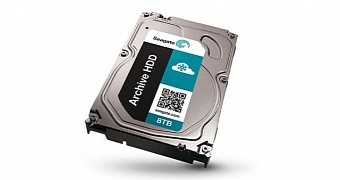Seagate has confirmed at Citigroup's global technology conference this week that it plans to keep its promises and release its first 10TB drives this year, as announced a while ago.
According to Dave Morton, the senior vice president of finance at Seagate, the company needs to refresh its product lines this year and it will do so by using the same technological features of the 2TB 2.5”/7mm drive with two platters it announced last week and expanding to larger capacity drives, reaching the 8TB and 10TB threshold.
Apparently, the drives are expected to be powered by six 1.66TB platters with 1.1Tbpsi (Terra-bit per square inch) areal density and will be placed in Seagate's Archive family of hard disks. The new drives could feature SRM (Shingled Magnetic Recording) tech as well, so don't expect great read/write speeds.
Right now, Seagate's largest HDD available is a 8TB capacity unit with six 1.33TB SMR platters, with similar models coming in the Enterprise Capacity, Enterprise NAS and Kinetic families of hard drives that come for different markets and clients.
The world's largest HDD, however, comes from HGST, a Western Digital division that offers a 10TB helium-filled, SMR-equipped monster powered by seven 1.43TB (~0.95Tbpsi areal density) SMR platters, and which is available only to a few Seagate customers for servers and data centers.
HDDs are indeed more cost-effective, but for a limited time
Although Seagate's recent announcement doesn't guarantee that any advanced HDD data storing technology will arrive this year, it doesn't deny the fact that the company is working on developing the heat-assisted magnetic recording technology (HAMR) to keep the pace with Samsung and Toshiba in SSD capacities, which have recently overcome HDDs.
At the moment, the largest disk drive in the world is Samsung's 16TB PM1633a V-NAND drive, while Toshiba promises that SSDs will reach 128TB by 2018. In these circumstances, HDDs are bound to enter a storage size race against SSDs, with major HDD manufacturers like Western Digital and Seagate investing big money in R&D to allow the good old platter to catch against the lightning fast V-NANDs.
According to KitGuru, Dave Morton finally admitted defeat in the field where HDDs once dominated - storage size - and claimed that SSDs would never match the per-gigabyte costs of HDDs, invoking the only temporarily advantage HDDs have over SSDs: cost effectiveness.
Right now, the most basic consumer-class 3TB HDD costs around $0.033 (3 cents) per gigabyte, while a low-cost 120GB SSD costs around $0.58 (58 cents) per gigabyte, so the advantage is in HDDs’ favor.
However, since Samsung announced that its 48-layer V-NAND memory would be much cheaper than the previous NAND, allowing larger, faster and cheaper memory chips to come to the market, it's clear that SSDs will soon win the price battle as well, entering the affordable price area of disk drives in a couple of years or even sooner.

 14 DAY TRIAL //
14 DAY TRIAL //